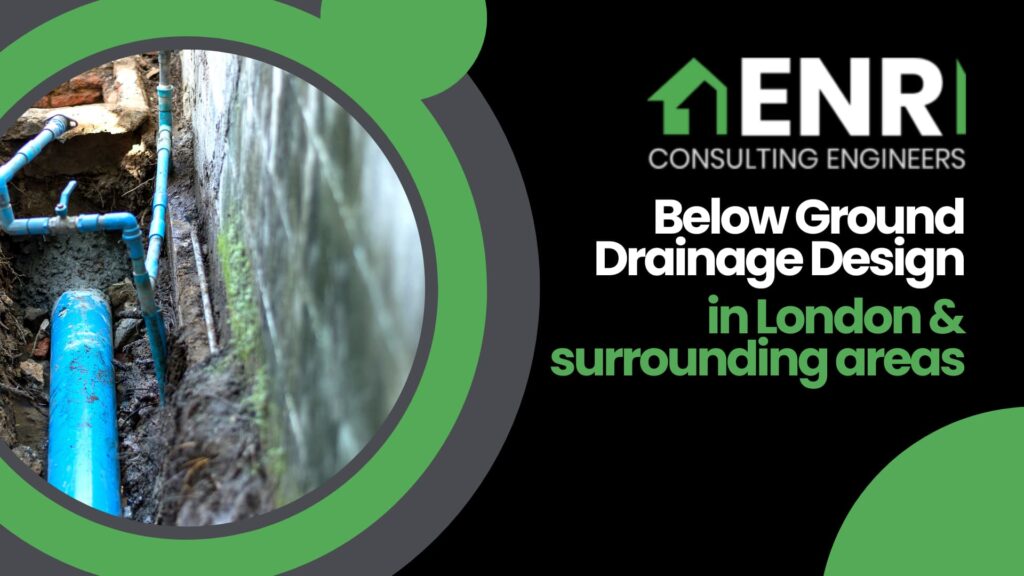How Civil Engineers Prevent Below Ground Drainage Issues
Below-ground drainage issues can be caused by a variety of factors, and can occur in all types of houses and properties. With significant implications for the stability and functionality of buildings, it’s crucial that problems and culprits are quickly identified and resolved.
Civil engineers play a crucial role in both preventing and addressing below ground drainage issues. In below ground drainage design and construction phases, engineers take the time to assess any potential disruptive factors and adjust accordingly to ensure the long-term stability and functionality of buildings.
Common Causes of Below Ground Drainage Issues
Blockages
Blocked drains are one of the most common causes of a dysfunctional drainage system.
- Tree roots can disturb, penetrate of block pipes, particularly in antiquated or less-inspected systems.
- Grease & fat build-up can restrict the flow in pipes, particularly those leading to a main sewer channel.
- Unwanted items like toys, rags or sanitary materials can become lodged in pipes.
Broken & Collapsed Pipes
- Over time, pipes can deteriorate and become damaged.
- Shifts in the ground or ground movement can cause pipes to break or collapse.
- Heavy machinery or heavy equipment can lead to pipe damage.
High Water Table
- Heavy rainfall, which isn’t uncommon in the UK, can raise the water table, putting pressure on drains and increasing the likelihood of a problem arising.
- Systems with poor soil drainage, or clay-rich soils which retain water, can lead to high water levels.
- Drainage systems with a lack of soakaways can lead to water not being drained away quickly enough.
Poor Installation
- If pipes are poorly laid or improperly joined, or not integrated at the correct gradient, they may not drain effectively.
- Insufficient venting can prevent drains from functioning properly.
Sediment Build-Up
- Over time, sediment can accumulate in pipes which reduces their capacity.
- Similarly, heavy rainfall can carry debris into drains and create build-up.
Other Factors
- Landscaping and construction can damage or disrupting draining systems.
How do Civil Engineers prevent Below Ground Drainage Problems?
Civil engineers play a crucial role in preventing below ground drainage issues by utilising numerous strategies during design, construction and maintenance project phases.
Site Analysis
With a thorough site inspection, civil engineers can conduct soil analysis to understand the soil type and its draining properties, determining the correct drainage system to integrate. Similarly, a hydrological assessment is conducted, analysing the local climate, rainfall patterns and water table levels to determine the required drainage capacity.
Design
When designing below ground drainage systems, specialists, such as ENR Consulting Engineers, will ensure that durable and corrosion-resistant materials for pipes and fittings are specified. Providing adequate sizing, making sure that pipes and channels contain the capacity to handle the expected water flow, civil engineers specify the appropriate gradients to maintain the correct slope for pipes to ensure efficient drainage.
Civil engineers also incorporate crucial elements to their design, such as soakaways and infiltration trenches to absorb excess water.
Attention to Detail
Civil engineers use careful construction practises to ensure pipes are laid at the specified depth and gradient, with proper joints and connections for long-lasting functionality.
Experienced engineers take precaution to avoid damage to existing underground infrastructure to providing protection during excavation, whilst properly backfilling trenches to prevent future settlement and pipe damage.
Maintenance
By conducting routine inspections and periodic checks, expert engineers can identify and address any potential issues with below ground drainage systems early on. Recommending personnel to remove debris, sediment and tree roots from drains to maximise their capacity, engineers can also advise if any repairs or replacements are required to pipes and fittings.
Below Ground Drainage Design by ENR Consulting Engineers
ENR Consulting Engineers are leading Essex-based providers of Below Ground Drainage Design, covering London and surround areas. Get started by filling out the enquiry form on out website.

